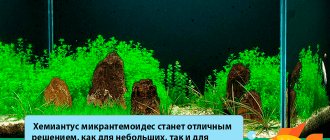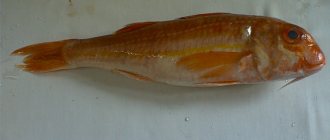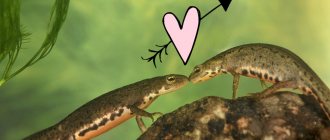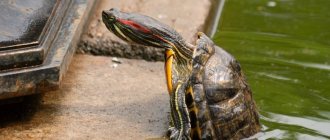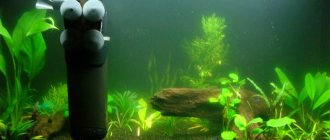A green lawn in your aquarium!
Hemianthus callitrichoides "Cuba" is perhaps the most popular aquarium ground cover plant that is widely used in aquascaping. Hemianthus callitrichoides "Cuba" was discovered by Wiedelouf Holger (founder of Tropica) while traveling along the rocky Cuban River, near Havana.
The plant gained popularity thanks to maestro Takashi Amano , who glorified it in his masterpieces. Since the beginning of the 80s, the plant has gained mass popularity; its excellent decorative properties have been appreciated by all aquascapers in the world.
Hemianthus cube is an excellent tool for creating underwater lawns; the plant forms a low, dense green carpet that beautifully covers the bottom of the aquarium. Moreover, with a sufficient concentration of CO2 and proper lighting, hemianthus cube creates an amazingly beautiful perling (bubbling) - oxygen bubbles, like beads, scatter across the entire bottom of the aquarium.
So let's take a closer look at this attractive plant.
Appearance and location in the aquarium
Hemianthus callitrichoides is a bottom plant, which belongs to the Norichnikov family; it has very small double opposite leaves 1.5 - 2 mm in size, sitting on thin petioles. The roots are thin, thread-like, weak, and easy to damage. As the plant grows, it forms colonies. Under favorable conditions, these colonies form a continuous carpet of bright green color.
When planting small fragments of a plant for the first time, it is preferable to give them the closest plan, since they will be completely lost in the middle or far corner.
Top dressing
One of the most important conditions for successfully growing hemianthus at home is the presence of a large number of fish in the aquarium. Fish waste products contain additional nutrients that create favorable conditions for the rapid growth of grass.
A few weeks after planting, the cube should begin to be fed with liquid iron-containing fertilizers. If this is not done or not done regularly, the small leaves of the hemianthus will quickly turn yellow. When adding the recommended amount of liquid fertilizer, the grass easily restores its original color.
IMPORTANT: If the water contains too much organic fertilizer and iron, the hemianthus darkens and becomes smaller. It may respond to excess iron by slowing down or stopping growth. In this case, you need to change the water and stop feeding the plant for a while.
Return to content
Water parameters
Hemianthus Cuba loves clean water, so filters are a must. It is also necessary to carry out timely cleaning of the bottom, protecting the soil from excessive siltation.- The preferred water hardness is no higher than seven degrees, which applies to both the calcium-magnesium and sulfate components. Soft water is closest to the natural growing conditions of the species.
- It is recommended to keep the acid-base balance at 5 - 7 Ph. Excessive leaching leads to oppression and death of the plant. However, the level is perfectly regulated with the help of nutrient soil.
- The saturation of the environment with carbon dioxide plays a special role in the dynamic growth of the colony. The indicator is normal at the indicated acidity parameters - 20 - 30 mg/l.
With sufficient CO2 and good light, Hemianthus Cube produces a curious effect: the formation of oxygen bubbles at the ends of the petioles and between opposing pairs of leaves.
The plant is demanding on the freshness of water. In a week it is necessary to replace from a third to a half of the total volume.
Compatibility
Hemianthus micranthemoides gets along well with other plants. But some types of fish and snails are able to eat the tender leaves of the plant. List of incompatible inhabitants. Barbs All cichlids Poecillia, including guppies and mollies. Any snails. List of compatible fish. Hemianthus gets along well with all the inhabitants of the aquarium not included in the previous list. During the spawning period, fry and females find reliable shelter in dense thickets. Diseases In general, the resilient and capricious hemianthus may well become ill if the minimum set of its requirements for environmental conditions is not met. Stopping growth.
Occurs if there is no or intermittent supply of carbon dioxide. The second reason is inappropriate pH balance. In this case, the plant’s leaves in the upper part of the stems also turn pale. The problem is resolved by changing the water, constantly supplying carbon monoxide and creating the correct pH above 6 units. The leaves were crushed, the shoots became very elongated and bare. Hemianthus clearly does not have enough light! Either he was planted in a dark corner, or the aquarium is equipped with too weak lamps. The plant must be moved directly under the light source. The leaves change color.
It may turn red or yellow. If this happens, it means that the plant is severely lacking nutrition. Liquid mineral fertilizers must be added to the water. Lifespan Hemianthus micranthemoides is a long-lived plant. It can live in an aquarium for years, constantly growing and renewing itself. Average price Pearl grass is sold in bunches of ten shoots each. The cost of a medium-sized bunch (10 branches) ranges from 45 to 60 rubles. A large bunch (20–25 branches) can be purchased for 120–140 rubles. Price varies depending on region.
Lighting
Lighting for Hemianthus callitrichoides should be strong or even higher. The reason for the high light requirement is the nature of the plant’s location. The light reaching the bottom is already largely scattered. To compensate for this effect, you need to choose a more powerful lamp. The norm for hemianthus is no less than 0.7, and even better, 1 W per liter (70 - 100 Lumens/liter).
With a lack of light, the stems and leaves of “Cuba” begin to stretch upward towards the light, reaching a height of six or even more centimeters. At the same time, there are no new shoots - the growth in width stops. The more light, the more noticeable the effect of the carpet.
How to plant Hemianthus correctly
Before planting, Hemianthus is divided into several groups. All long (more than 5 cm) roots must be removed.
There are two ways to plant a plant:
- separately for each root: it is necessary to plant the seeds in fine-grained soil in a checkerboard pattern using tweezers, leaving 1 cm between them.
- groups: each part of the plant must be placed in a hole made in advance in the ground and filled in. The distance between planted groups should be more than or equal to 2 cm. This method is often used when planting a plant over a relatively large area.
To prevent Hemianthus from floating to the surface of the water, it is recommended to leave only the leaves outside when planting. Aquarists also advise securing newly planted sprouts with paper clips or pebbles.
For planting in an aquarium, aquadesigners advise buying Hemianthus of palludarium form, that is, grown in a pot, since such a plant will better adapt to the new aquarium environment.
Primer and substrate
Fine-fraction expanded clay
river sand
Vermicompost
Ada Amazonia
Due to the weakness of the root system, the soil should be light. Fine expanded clay can be used as a neutral component. Coarse river sand will be preferable to pebbles. Another option would be vermicompost - agricultural waste processed by earthworms and other organisms.
However, it is best to use branded nutrient soil for aquascaping from reputable manufacturers. For example, Ada Amazonia is the best option due to the strength of the granules, but if you don’t have money, you can use a simpler nutrient soil.
Fertilizers, propagation, cutting
An aquarium with Hemianthus Cuba must be topped up with a standard macro complex. Of the microelements, iron is of particular importance for the plant - it is added in the form of gluconate at the rate of at least 5 mg/l per week.
It is quite easy to get a new group of shoots - after the growth of green mass, part of the plant is simply carefully cut off with scissors or a sharp knife. When purchasing Hemianthus Cuba, you should focus on a meristem culture.
With abundant growth of Hemianthus callitrichoides, the green mass begins to grow not only in width, but also in height, even if the lighting is strong. To do this, a haircut procedure is carried out using special curved scissors.
Origin of the plant
Hemianthus callitrichoides "Cuba" was first noticed in the bed of one of the rapids of the Cuban rivers near Havana by Widelouf Holger, traveling in the Caribbean.
Thanks to Holger, the creator of the Danish one, the plant gained popularity and spread throughout the world. The scientist was amazed by the beautiful stones in local reservoirs and, looking closer, he noticed that the stones were covered with interesting microthickets.
He brought the ground cover to his homeland in the 70s, where his employees adapted the grass for aquariums and began to breed it. The popularity of hemianthus was promoted by Takashi Amano, who spoke admiringly about the plant. Aquascapers in Europe and then Russia quickly learned about the decorative properties of this hardy hydrophyte.
The ground cover has not been found in other bodies of water, only its relative, Hemianthus micranthemoides, growing in North America.
Thanks to Mr. Hogler and his company Tropica, Hemianthus callitrichoides cubeba was brought and adapted for keeping in aquariums.
Rooting problem
In order for Hemianthus Cuba to grow in an even carpet, it must be fixed in the soil. This is quite difficult, the plant periodically floats to the surface. You have to use little tricks.
For art objects
If you need to overgrow a smooth stone, do this: take a mesh made of synthetic threads - they will not rot in water. Having taken the stone out of the water and dried it, we straighten the mesh on it and glue the edges with ethyl cyanoacrylate. After polymerization it becomes completely neutral. To make the glue voluminous and grip well, first apply a drop to the stone at the place where the mesh is attached, and sprinkle a pinch of regular baking soda on top. The cyanoacrylate will instantly harden - after which the stone can be placed on the bottom and hooked into the cells of the Hemiantus Cube mesh.
Cheap and cheerful
You take paper clips in a synthetic braid, first bend them, then form a hook in the shape of the letter U. You hook one end to the ground, and secure the other in the colony.
Trimming
Hemianthus micranthemoides tolerates shearing painlessly. Growth is not slowing down. Leaf color does not reduce intensity. Pruning the top shoot stimulates the appearance of lateral whorls. The density of the bush increases. Perform pruning using sharp scissors.
Avoid cutting in large volumes. It is fraught with a violation of biological balance.
Greenhouse cultivation
Despite all its capriciousness, Cuba grows well in the air. To organize a mini-greenhouse, any container made of transparent food-grade plastic, for example, a container with a lid or a cut bottle, is suitable.
The sequence of actions is as follows:
gravel or coarse sand at the bottom;- as a nutritional substrate, standard soil for indoor plants / a little vermicompost / ordinary garden soil, sifted and disinfected;
- Lightly press the Hemianthus roots into the soil, but do not dig them in;
- water generously and spray constantly, keeping the substrate moist;
- A lid or cover glass is desirable on top, as well as good lighting (in summer and spring, natural light is sometimes enough on sunny windows).
Errors
- Long lamp operation. Turn on the lights for 8-12 hours a day. Long daylight hours will harm the plants and cause an algae outbreak. It is also impossible to compensate for insufficient light power by lengthening daylight hours.
- Lighting of the wrong spectrum. Cuba requires light in shades of blue and red.
- Incorrect water changes. Do not pour tap water into the aquarium. Leave the liquid to stand for at least a day or dechlorinate with air conditioners. The replacement water parameters must be identical to the aquarium water parameters. It is also impossible to change a large volume at a time, this will shake the biological balance.
- Keeping in unsuitable conditions. Monitor water parameters and equipment operation.
Similar species
In 2010, the plant Micranthemum Monte Carlo was discovered. It also belongs to the ground cover, but has a number of advantages over Hemianthus:
- it has longer roots, so there is no problem of the colony emerging;
- Average lighting parameters are sufficient (0.5 W/liter);
- less demanding on the presence of CO2 and the addition of fertilizer.
Hemianthus callitrichoides is a very beautiful ground cover plant, by breeding which you can gradually move from an ordinary amateur aquarium to aquascaping. Despite some capriciousness, the plant will reward the attentive owner with a lush carpet of emerald greenery.
Main characteristics
Despite its modest size, the grass has a tenacious root, which helps it take root in rocky soil and make its way to nutrients among relatives located a few millimeters from each other. It prefers silty soil, but even with good nutrition in an aquarium, it has average growth vigor. In terms of complexity of maintenance, this ground cover can be classified as medium complex. Benefits of planting:
- the ability to create an underwater landscape in the aquascape style;
- highly decorative;
- ability to root on horizontal and inclined surfaces.
And these are not all the benefits of growing ornamental grass. For those who manage to create the right conditions, the green mat will present an interesting spectacle - the bubbling of plants. Accumulating oxygen during the daytime, by evening hemianthus begins to actively release it, forming an endless fireworks of air bubbles. Observing such a phenomenon is very fascinating and no other plant will demonstrate it as clearly as hemianthus.
